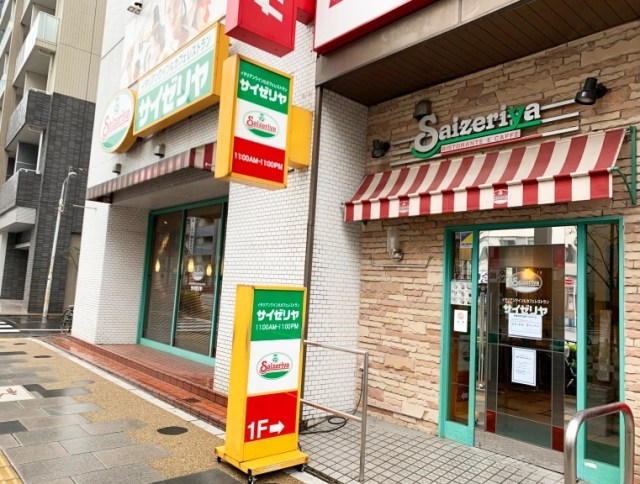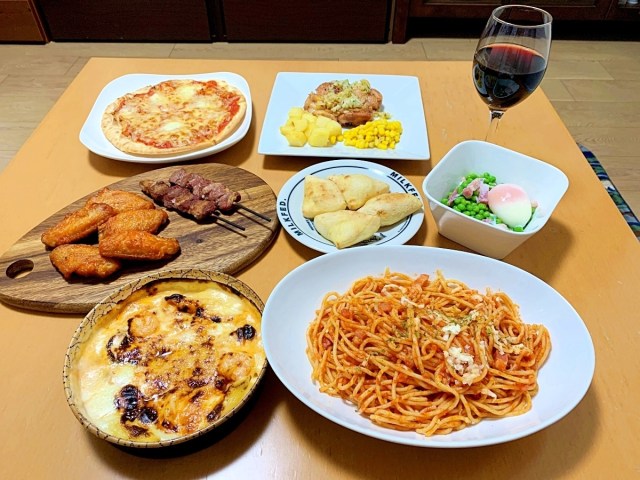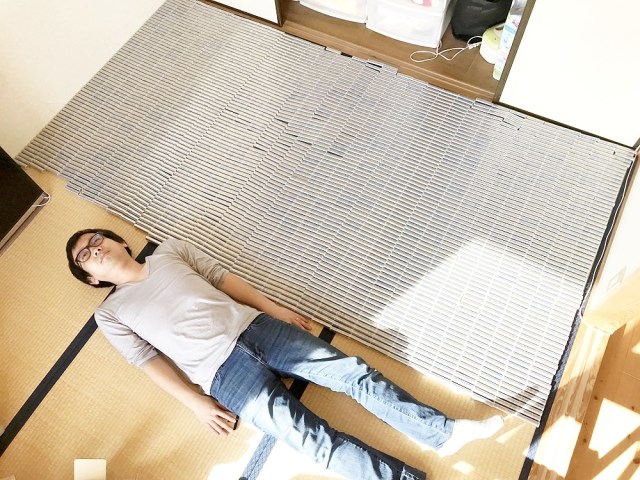
Saizeriya’s price bump isn’t an economic decision, it’s a health one.
For decades, restaurant chain Saizeriya has been an oasis for budget-conscious diners in Japan. Yes, the name on the door, “Saizeriya Ristorante e Caffé,” sounds fancy, but Saizeriya offers some of the cheapest sit-down meals in all of Japan, and is often even more affordable than fast food joints with its doria (baked rice and cheese dishes) for just 299 yen (US$2.80) and pizzas and pasta for 399 yen.
So those whose first instinct is to check their wallet when they hear their stomach growling, such as students, part-timers, and Internet writers, were holding their breath when it was announced last month that Saizeriya would be raising its prices on 140 different menu items. They got to breathe a sigh of relief, though, when they found out the increase for those items, which went into effect at the start of July, was just one yen (less than one U.S. cent).
▼ One of our previous Saizeriya feasts
So why the miniscule price bump? For the same reason a lot of things are happening these days: the coronavirus.
Because Saizeriya lists its prices as after tax, the restaurant doesn’t have a service charge, and there’s no tipping in Japan, if you order a 399-yen pizza Margherita, that’s exactly what you’re paying. Rather than count out 399 yen in change, though, most customers will just use four 100-yen coins, which means they’ll be getting a one-yen coin back in change. People who’d have been ordering Saizeriya’s 399-yen hamburger steak, 299-yen spaghetti pepperoncino, or 999-yen rib eye steak (the most expensive thing on the menu) faced a similar scenario.
In a time when hand hygiene is of the utmost importance, Saizeriya decided to rethink the effects of its pricing system. Yes, 299 yen is obviously cheaper for customers than 300 yen, and psychologically it makes an item an easier purchase, which helps Sazeriya’s bottom line. But with coins being a potential conduit for all sorts of gross germs, ultimately the chain feels that this probably isn’t the right time to be handing out so much change, and so it decided to bump items with a price ending in 99 up one yen for an even number and fewer coins to put in customers’ hands.
▼ We know all too well what’s it’s like to have too many 100-yen coins.
Extending that logic, Saizeriya has reworked its prices so that all items now have a price ending in either 00 or 50, negating the need to give customers any one, five, or ten-yen coins as change. And while that means higher prices (by as much as 21 yen) for the majority of the menu, there are also a few items that are now cheaper than they were before, such as rice (now 19 yen cheaper), garlic bread, and focaccia (both 11 yen cheaper).
Between the revised prices and greater promotion of cashless payment systems, Saizeriya hopes to reduce the number of coins it gives out as change by 80 percent. And even if some of our favorite items now cost us one yen more, Saizeria is still one of the least expensive places to fill up in Japan, even if you’re actively trying to run up the highest bill you can.
Sources: Toyo Keizai via Hachima Kiko, Saizeriya, Sankei Biz
Photos ©SoraNews24
● Want to hear about SoraNews24’s latest articles as soon as they’re published? Follow us on Facebook and Twitter!



 Is it possible to run up a 100,000-yen (US$885) bill at Tokyo’s cheapest Italian restaurant?
Is it possible to run up a 100,000-yen (US$885) bill at Tokyo’s cheapest Italian restaurant? Super budget dining in Japan – What’s the best way to spend 1,000 yen at restaurant Saizeriya?
Super budget dining in Japan – What’s the best way to spend 1,000 yen at restaurant Saizeriya? Japan Super Budget Dining – What’s the best way to spend 1,000 yen at Saizeriya?
Japan Super Budget Dining – What’s the best way to spend 1,000 yen at Saizeriya? Survey picks Japan’s top 12 cheap chain restaurants
Survey picks Japan’s top 12 cheap chain restaurants Japan’s top 10 best-value family restaurants, as chosen by diners
Japan’s top 10 best-value family restaurants, as chosen by diners Japanese beef bowl chain Sukiya’s 2026 Smile Box lucky bag basically pays for itself
Japanese beef bowl chain Sukiya’s 2026 Smile Box lucky bag basically pays for itself Rakuten randomly offers 58 New Year’s osechi feasts in Japan, but did we get a star or a dud?
Rakuten randomly offers 58 New Year’s osechi feasts in Japan, but did we get a star or a dud? Majority of Japanese mayors say foreign residents are essential but most see good and bad effects
Majority of Japanese mayors say foreign residents are essential but most see good and bad effects Japan’s new difficult-to-drink-from beer glass protects your liver, but it’s a brutal experience
Japan’s new difficult-to-drink-from beer glass protects your liver, but it’s a brutal experience New train recreates hotel atmosphere with wood interiors and views from the foot of Mount Fuji
New train recreates hotel atmosphere with wood interiors and views from the foot of Mount Fuji 100 years of Japanese women’s hair and makeup trends in less than a minute and a half【Video】
100 years of Japanese women’s hair and makeup trends in less than a minute and a half【Video】 Original Totoro plush toys from 80s and 90s re-issued for Studio Ghibli exhibition
Original Totoro plush toys from 80s and 90s re-issued for Studio Ghibli exhibition The dark kawaii fashions of the Ank Rouge lucky bag are here!【Photos】
The dark kawaii fashions of the Ank Rouge lucky bag are here!【Photos】 4chan creator hands reins over to 2channel’s Hiroyuki Nishimura
4chan creator hands reins over to 2channel’s Hiroyuki Nishimura Disney villain-themed eyeglasses in four styles up for presale in Japan
Disney villain-themed eyeglasses in four styles up for presale in Japan Starbucks Japan ready to get Year of the Horse started with adorable drinkware and plushies【Pics】
Starbucks Japan ready to get Year of the Horse started with adorable drinkware and plushies【Pics】 Hayao Miyazaki says Happy New Year to Studio Ghibli fans with new art for Year of the Horse
Hayao Miyazaki says Happy New Year to Studio Ghibli fans with new art for Year of the Horse We found possibly the quietest Japanese-style hotel in Tokyo’s bustling Shinjuku district
We found possibly the quietest Japanese-style hotel in Tokyo’s bustling Shinjuku district Cup Noodle tries an authentic Jiro-style ramen, but something’s not quite right
Cup Noodle tries an authentic Jiro-style ramen, but something’s not quite right The best Starbucks Japan Frappuccinos we want to drink again in 2026
The best Starbucks Japan Frappuccinos we want to drink again in 2026 We revisited Sweets Paradise after a decade to see if Japan’s dessert buffet still delivers
We revisited Sweets Paradise after a decade to see if Japan’s dessert buffet still delivers That time Seiji called JASRAC to ask why he didn’t get paid royalties for his song being on TV
That time Seiji called JASRAC to ask why he didn’t get paid royalties for his song being on TV Japan’s oldest largetooth sawfish in captivity back on display in Mie Prefecture
Japan’s oldest largetooth sawfish in captivity back on display in Mie Prefecture Pizza Hut Japan’s hot lucky bags are perfect for a New Year’s pizza party
Pizza Hut Japan’s hot lucky bags are perfect for a New Year’s pizza party 7-Eleven Japan starts new temporary luggage storage service in over 300 branches
7-Eleven Japan starts new temporary luggage storage service in over 300 branches Disillusionment at Tsukiji’s tourist-target prices led us to a great ramen restaurant in Tokyo
Disillusionment at Tsukiji’s tourist-target prices led us to a great ramen restaurant in Tokyo Starbucks teams up with 166-year-old Kyoto doll maker for Year of the Horse decorations【Photos】
Starbucks teams up with 166-year-old Kyoto doll maker for Year of the Horse decorations【Photos】 Tokyo considering law requiring more trash cans following litter increase in heavily touristed area
Tokyo considering law requiring more trash cans following litter increase in heavily touristed area Tokyo’s Tsukiji sushi neighborhood asks tour groups to stay away for the rest of the month
Tokyo’s Tsukiji sushi neighborhood asks tour groups to stay away for the rest of the month Tokyo event lets you travel back in time, for free, to celebrate 100 years since Showa era start
Tokyo event lets you travel back in time, for free, to celebrate 100 years since Showa era start Japan may add Japanese language proficiency, lifestyle classes to permanent foreign resident requirements
Japan may add Japanese language proficiency, lifestyle classes to permanent foreign resident requirements Sanrio theme park in Japan announces plans to expand into a Sanrio resort
Sanrio theme park in Japan announces plans to expand into a Sanrio resort Stamina-destroying “Paralysis Noodles” are Tokyo’s newest over-the-top ramen innovation
Stamina-destroying “Paralysis Noodles” are Tokyo’s newest over-the-top ramen innovation Survey asks foreign tourists what bothered them in Japan, more than half gave same answer
Survey asks foreign tourists what bothered them in Japan, more than half gave same answer Japan’s human washing machines will go on sale to general public, demos to be held in Tokyo
Japan’s human washing machines will go on sale to general public, demos to be held in Tokyo Japan’s deadliest food claims more victims, but why do people keep eating it for New Year’s?
Japan’s deadliest food claims more victims, but why do people keep eating it for New Year’s? We deeply regret going into this tunnel on our walk in the mountains of Japan
We deeply regret going into this tunnel on our walk in the mountains of Japan Studio Ghibli releases Kodama forest spirits from Princess Mononoke to light up your home
Studio Ghibli releases Kodama forest spirits from Princess Mononoke to light up your home Major Japanese hotel chain says reservations via overseas booking sites may not be valid
Major Japanese hotel chain says reservations via overseas booking sites may not be valid Put sesame oil in your coffee? Japanese maker says it’s the best way to start your day【Taste test】
Put sesame oil in your coffee? Japanese maker says it’s the best way to start your day【Taste test】 No more using real katana for tourism activities, Japan’s National Police Agency says
No more using real katana for tourism activities, Japan’s National Police Agency says Starbucks Japan reveals new sakura drinkware collection, inspired by evening cherry blossoms
Starbucks Japan reveals new sakura drinkware collection, inspired by evening cherry blossoms Updated cherry blossom forecast shows extra-long sakura season for Japan this year
Updated cherry blossom forecast shows extra-long sakura season for Japan this year Naomi Watanabe releases new clothing collaboration with Japanese restaurant chain Saizeriya
Naomi Watanabe releases new clothing collaboration with Japanese restaurant chain Saizeriya To entice customers, Japanese restaurant Saizeriya creates mask you can wear while eating【Video】
To entice customers, Japanese restaurant Saizeriya creates mask you can wear while eating【Video】 New Saizeriya gacha toys make us severely regret our life choices as we defy rules of probability
New Saizeriya gacha toys make us severely regret our life choices as we defy rules of probability We almost cried on our first visit to this under-the-radar budget Italian restaurant in Japan
We almost cried on our first visit to this under-the-radar budget Italian restaurant in Japan Ultimate Japan Super Budget Dining! Our very best 1,000-yen chain restaurant meals this year
Ultimate Japan Super Budget Dining! Our very best 1,000-yen chain restaurant meals this year Super Budget Dining in Japan – What’s the best way to spend 1,000 yen (US$6.70) at Saizeriya?
Super Budget Dining in Japan – What’s the best way to spend 1,000 yen (US$6.70) at Saizeriya? How to make an epic pizza at a Japanese family restaurant
How to make an epic pizza at a Japanese family restaurant How many rare coins are in our pile of 100,000 one-yen coins?
How many rare coins are in our pile of 100,000 one-yen coins? Japan’s most popular curry rice restaurant chain losing customers as it raises prices
Japan’s most popular curry rice restaurant chain losing customers as it raises prices Is downtown Tokyo’s crazy cheap 290-yen bento boxed lunch shop still around, and is it still cheap?
Is downtown Tokyo’s crazy cheap 290-yen bento boxed lunch shop still around, and is it still cheap? New Tokyo restaurant charges higher prices to foreign tourists than Japanese locals
New Tokyo restaurant charges higher prices to foreign tourists than Japanese locals 10-yen sushi? Such wonders do exist at new Tokyo restaurant in Shinjuku
10-yen sushi? Such wonders do exist at new Tokyo restaurant in Shinjuku What’s the best way to spend 1,000 yen at Denny’s in Japan?
What’s the best way to spend 1,000 yen at Denny’s in Japan? Clam chowder tempura being offered by Japan’s most popular tempura restaurant chain
Clam chowder tempura being offered by Japan’s most popular tempura restaurant chain Japanese wife creates izakaya pub at home during coronavirus outbreak
Japanese wife creates izakaya pub at home during coronavirus outbreak
Leave a Reply